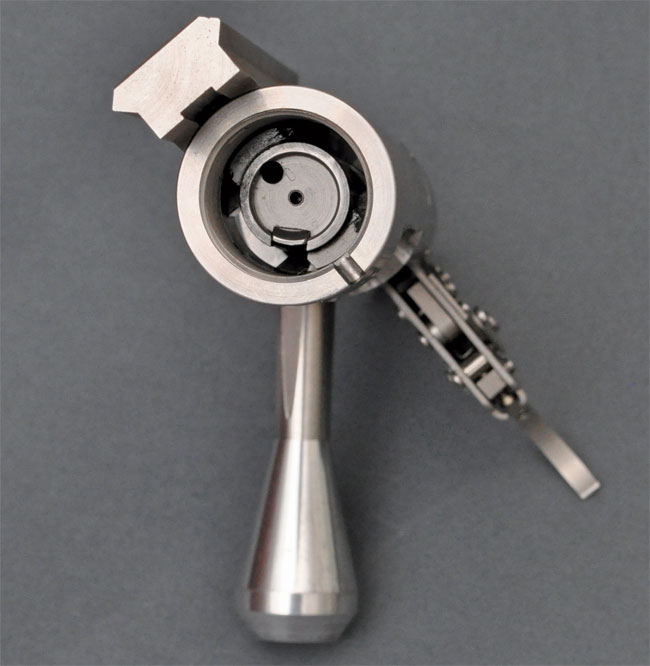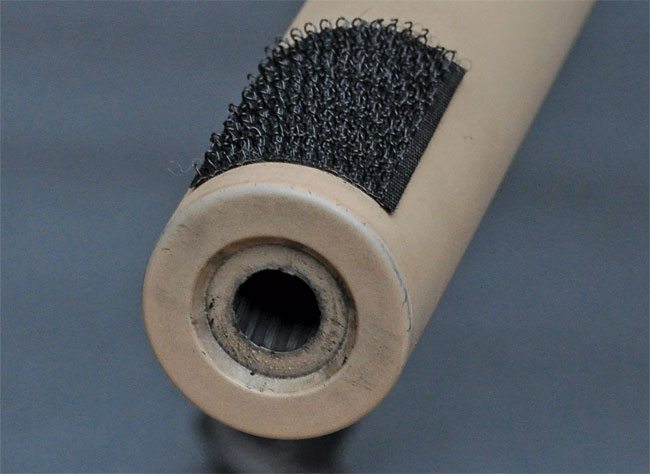The Bolt
Its shape is reminiscent of typical American bolts; however, that is just a superficial similarity. The bolt is also obtained from a single block and is perfectly monolithic and seamless. The use of semi-worked blocks also allows the extraction of a single piece for the handle as well as the two oversized lugs, which guarantee better safety and precision. The bolt body is fluted with a pronounced helical milling, useful in normal use to retain lubricants and, in the countryside, to get rid of dirt. In very low temperatures this solution also enables you to break any ice deposits.
The handle is made from steel containing a high percentage of molybdenum and the knob is made from an aeronautical aluminum based alloy 7075-T6. These are joined by a special screw-locking system and the buyer can choose knobs of different shapes and sizes as well as fluted ones, which facilitate the operating of the bolt smoothly even when wearing gloves. Another peculiarity consists in the extraction system based on that developed by the Finnish arms producer, Sako: the extractor is the same as those normally designed for magnums and is actuated by a spring pin that holds it in the socket on the furrow from the face of the cartridge cases propelling rear. This solution on one hand ensures robustness and, in extreme cases, the rapid replacement of the component, which can be done directly in the field with appreciable ease. The firing pin is made from steel and light alloy, in order to increase the speed of percussion.
The Rail and Accessories
The rail is also made from Type 416 steel in the factory in Suzzara and can be bought at several levels of inclination, ranging from flat to 10, 20, 30 and MOA of angle. A peculiarity of the rail is the way it is mounted to the action, which is not using the classic American thread type 8/40 inch. Plugs are used with limited tolerance (H6) for the centering of the work piece and fine-pitch screws (5/32”) locking whose job is not to ensure perfect co-axial connection with the weapon but simply to keep it well anchored. The rail is configured in the classical Picatinny-weaver and Picatinny style. The design of the rail means that the front is over the barrel with a gap of one tenth of a millimeter; which is completely free floating and will not make contact with each other when firing. Among the other accessories we should mention, is the detachable five-shot magazine made by Accuracy International and an American Harris bipod available in the fixed configuration mode.

Dedicated Scope
Sirarms, in producing this excellent shooting platform, has not overlooked the smallest detail, and particular attention has been paid to the selection of telescopic sights to put in combination with the firearm. In this specific case, the decision was made to contact one of the leading producers of telescopic sights: the German company, Schmidt und Bender, and ask them for a customized version of one of their best long range shooting scopes: the model 12-50 x 56 type PMII with a 34mm tube diameter. The elevation turret is the “multi-turn” on clockwise rotation per click 1/4 cm from 0 to 175 cm, i.e. 60MOA of total vertical. The windage turret is instead the more classical “double-turn” type (letter. “double regulation”) 1/8 MOA in clockwise rotation with a positive or negative change of 15 MOA for a total range of 30 MOA. The reticle is on the 2nd focal plane, type P4 fein. The American P.R.I. rings were chosen with six screws per ring as the feature to keep the two components firmly connected.
Testing and Conclusions
Writing an evaluation of a weapon for an article is a daunting task: there are numerous limitations of each test, which need to be put into context, many human subjective limits and, in addition, it is not always possible to fully exploit the true potential of weapon tested, either because of shooting range restrictions or bad weather. So it was that when testing the Sir40-24 our team was unable to fire the weapon as we would have liked at its maximum range.

Bearing in mind the above limitations, we tried our best by inspecting the rifle first in the armory, and later, by several firing exercises. Our analytical approach therefore departed from a real technical report held by Antonio Sirini and a discussion with armoror Luciano Turani and shooting instructor Alberto Maggio of the 911 Armory in Lograto.
In the first situation we tried to understand the reasoning behind the actual mechanics of the weapon and its overall design. The firing was done at the great indoor shooting range called “La galleria del tiro” (The shooting gallery) which has very different “atmospheric” conditions to a normal outdoor range. The aim was to judge it from an ergonomical and functional point of view. We used our already well tested Remington SS 5R in .308Win in parallel in order to have a comparison. It is a more economical firearm, however, it shoots very tight groups at 300m (approx.: 330 yards). This then allowed us to have a debate on the virtues and any issues with the Sir40-24 as we had a benchmark by which to judge it. The Sir40-24 was also tested at an outdoor range (TSN Codogno) at various ranges to test both the accuracy and ammunition used. The results obtained can be viewed in a broader context, that is to say by the results attained in completion and the results from those firearms destined for the police and military where the Sir40-24 can be considered the revelation of the “made in Italy” at this moment in time. Therefore, having presented the framework of our experiments we turn to our personal impressions of this beautiful rifle, given that we are talking about a product that aims to achieve the highest results, it therefore needs the right ammunition and an adequate shooter.
Generally speaking, the weapon seems to be inspired by some US products, however, Sirarms ramped it up in terms mechanical components that have nothing to do with the mass produced rifles regarding the types precision machining techniques used. In reference to the overall range of Sirarms products it is important to remember that the Sir40-24 forms the entry level rifle, but not due to any deficiency in it: it is simply a precision target shooting rifle that has a more classical format with regards to other firearms in terms of size and stock, taking advantage of their own products. The mechanics of the weapon are technically and qualitatively identical to the rest of the Sirarms range, which is characterized by an obsessive attention to production and production quality.
The performance of the rifle was generally very favorable. It is very well balanced for the recoil when pulling the trigger, which was properly limited. This allowed us to see how much it would recoil when not pressed against the shoulder: it came back about an inch. This allows for great shooting and would help shooters avoid any form of slapping at the trigger or flinching as it almost feels like firing a .22 LR caliber rifle. The trigger pull is light but not too much so and is very fluid. The bolt action movements are impeccable. The scope, bipod and rings are all of excellent quality, however as with the other accessories, it is subjective although we tested the rifle as objectively as possible. Therefore, we can easily conclude that the Sir40-24 in the hands of an expert shooter this rifle has everything going for it to excel in any competition and, not only there, Antonio Sirini has dreamt of producing a true sniper platform.
Will he achieve it? There is a distinct possibility. However, not being a mass producer and a private enterprise at that, it will not be easy to interact with the Armed forces above a certain level before being entangled in public administration. For our part, we wish him all the possible success he deserves, we would be happy to help document his challenging and exciting journey to having his rifles entering law enforcement and/or military service. That would make it the first Italian made sniper rifle.






